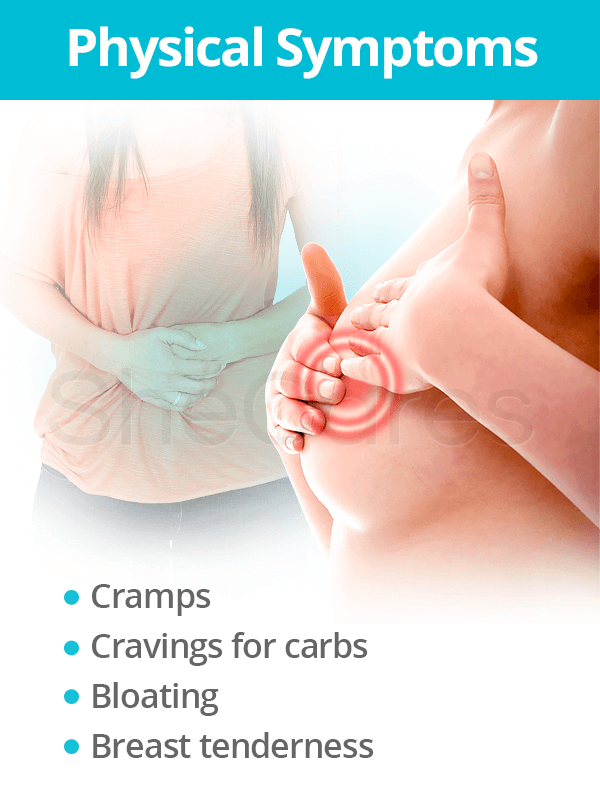Varying high estrogen symptoms may occur simultaneously or one after another with differing levels of intensity and duration.
Continue reading to learn more about the signs and symptoms of high estrogen levels to prevent a constant buildup of ailments from turning more critical.
Symptoms of High Estrogen Levels
Even though many high estrogen symptoms are universally associated with the transition into a woman's infertile years, they can occur at any age and are often incorrectly connected to other conditions.

Without a doubt, the list of symptoms is diverse with the effects of too much estrogen sometimes very subtle, making monitoring levels all the more important.
Physical Symptoms
- Headaches
- Cramps
- Carbohydrate cravings
- Water retention and bloating
- Fatigue
- Hot flashes
- Breast tenderness
- Decreased libido
- Increased PMS symptoms
Psychological Symptoms

- Irritability
- Difficulty concentrating
- Low self-esteem
- Mood swings
Aside from aforementioned symptoms, less common physical manifestations can also be vaginal infections; nausea; vomiting; and fibrocystic breasts while mental health symptoms include panic attacks and memory loss.
Signs of High Estrogen Levels

Medical signs are quantifiable tests that doctors analyze in order to diagnose a patient with a certain condition. When paired with symptoms of high estrogen, these signs will help distinguish the underlying cause of the hormonal imbalance.
- Vaginal infection (Positive tests showing bacterial or fungal growth)
- Hair loss (Diagnosed by doctor through visible scalp-wide hair loss)
- Fibrocystic breasts (Positive mammogram or ultrasound results)
- High levels of estrogen (Confirmed by blood tests)
- Low serotonin levels by blood tests
- Mental health consultations
Moreover, the presence of high estrogen levels can lead to a host of more serious disorders if the imbalance evolves into a state of estrogen dominance. These ailments include, but are not limited to, the following:
- Breast, ovarian, and uterine cancer
- Thyroid dysfunction
- Heart disease
- Allergies
- Endometriosis
- Uterine fibroids
- And more
There is a direct relationship between breast cancer and high estrogen levels. Certain types of breast cancer - such as hormone receptor-positive breast cancer - have receptors estrogen attaches to, which helps the cancer manifest.
Continue reading to learn more about lowering estrogen levels as a first step toward preventing further difficulties.
Sources
- American Cancer Society. (2016). Hormone Therapy for Breast Cancer. Retrieved August 31, 2017, from https://www.cancer.org/cancer/breast-cancer/treatment/hormone-therapy-for-breast-cancer.html
- Breastcancer.org. (2008). High Estrogen Levels May Lead to Recurrence. Retrieved August 31, 2017, from http://www.breastcancer.org/research-news/20080306b
- Kingsberg, S.A. et al. (2009). Treating dyspareunia caused by vaginal atrophy: a review of treatment options using vaginal estrogen therapy. International Journal of Women's Health, 1, 105-111. Retrieved August 29, 2017, from https://www.ncbi.nlm.nih.gov/pmc/articles/PMC2971714/
- Mayo Clinic. (n.d.). Fibrocystic breasts: Diagnosis. Retrieved August 31, 2017, from https://www.mayoclinic.org/diseases-conditions/fibrocystic-breasts/diagnosis-treatment/diagnosis/dxc-20195820
- The North American Menopause Society. (2010). Changes in Hormone Levels. Retrieved August 29, 2017, from https://www.menopause.org/for-women/sexual-health-menopause-online/changes-at-midlife/changes-in-hormone-levels
- Watson, C. (2003). User's Guide to Easing Menopause Symptoms Naturally. New Jersey: Basic Health Publications, Inc. Available from Google Books.
